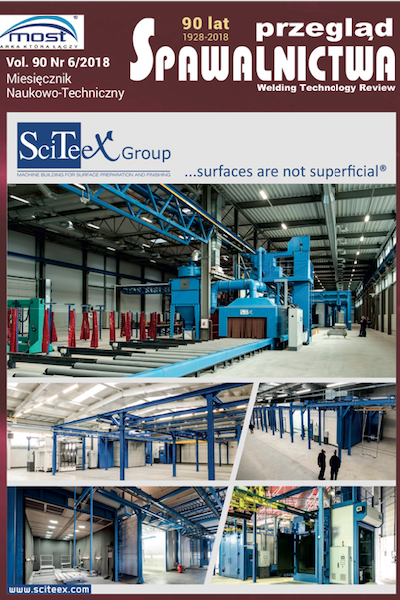Structural aspects of heterogeneous welded joints made of Super 304H and T91 steel
Main Article Content
Abstract
The paper presents the results of macro- and microscopic tests of heterogeneous welded joints made of Super 304H steel and T91 steel. The examined welded joints were made with the 141 (TIG) method in the PF welding position, using a Metrode EPRI P87 wire as the additional material. The tests were performed on the joint after welding and after heat treatment which consisted in the stress relief annealing at the temperature of 760 °C and soaking time of 2 hours. The investigated joints were marked respectively: S1 (the joint with- out heat treatment) and S2 (the joint after heat treatment). The process of welding, as well as the heat treatment in the area of the heat-affected zone (HAZ) in the case of Super 304H steel contributed to the precipitation processes mostly on the boundaries of grains. In the HAZ of T91 steel these processes caused the development of a degraded martensitic structure with numerous precipitates of diverse morphology.
Downloads
Article Details
Creative Commons CC BY 4.0 https://creativecommons.org/licenses/by/4.0/
Welding Technology Review (WTR) articles are published open access under a CC BY licence (Creative Commons Attribution 4.0 International licence). The CC BY licence is the most open licence available and considered the industry 'gold standard' for open access; it is also preferred by many funders. This licence allows readers to copy and redistribute the material in any medium or format, and to alter, transform, or build upon the material, including for commercial use, providing the original author is credited.
References
Zalecki W., Wrożyna A., Zieliński A.: Analiza zmian mikrostruktury stali dla energetyki poddanych cyklicznym zmianom temperatury i/lub obciążenia przy wykorzystaniu możliwości nowoczesnego dylatometru odkształceniowego, Prace Instytutu Metalurgii Żelaza, 69, 2017, s. 45-54.
Pańcikiewicz K., Ślązak B., Tasak E.: Właściwości mechaniczne i mikrostruktura spoiwa EPRI P87, Materiały i technologie stosowane w budowie kotłów o parametrach nadkrytycznych o temperaturze pary do 700 °C: pod red. Hernas A., Pasternak J., Ostaniec 2013, s. 337-348.
PN-EN ISO 14175:2009 Materiały dodatkowe do spawania Gazy I mieszaniny gazów do spawania i procesów pokrewnych.
Świadectwo jakości producenta prętów Metrode EPRI P87.
PN-EN ISO 15614-1 Specyfikacja i kwalifikowanie technologi spawania metali Badania technologii spawania Część 1: Spawanie łukowe i gazowe stali oraz spawanie niklu i stopów niklu.
PN-EN 1321:2000 Spawalnictwo. Badania niszczące metalowych złączy spawanych. Badania makroskopowe i mikroskopowe złączy spawanych.
PN-EN ISO 5817:2014-05 Spawanie Złącza spawane ze stali, niklu, tytanu i ich stopów (z wyjątkiem spawanych wiązką) Poziomy jakości według niezgodności spawalniczych.
Hernas A.: Żarowytrzymałość stali i stopów, Część I, Wyd. Politechniki Śląskiej, Gliwice 1999.
Chengyu C., Hongyao Y., Xishan X.: Advanced austenitic heat-resistant steels for ultra-super-critical fossil power plants, Alloy steel properties and use InTech 2011, s. 171-200.
Golański G., Kolan C., Jasak J., Słania J., Urbańczyk P., Zieliński A.: Mikrostruktura i właściwości mechaniczne stali TP347HFG po długotrwałej eksploatacji, Energetyka, 11, s. 655-657.
Tasak E.: Metalurgia spawania, Wydawnictwo JAK, Kraków 2008.
Sourmail T.: Precipitation in creep resistant austenitic stainless steel, Mater. S. Techn. 17, 2001, s. 1-14.
Golański G., Kolan C., Zieliński A., Urbańczyk P.: Degradacja struktury żarowytrzymałych stali austenitycznych, Energetyka, 11, 2017, s. 727-730.
Clark J.W.G.: Investigating chemical and microstructural evolution at dissimilar metal welds, EngD thesis from University of Nottingham, UK, 2015.
Sorrentino S.: Welding technologies for ultra-supercritical power plant materials, Materials for Ultra-Supercritical and Advanced Ultra-Critical Power Plants, 2017, s. 247-319.
Słania J., Urbańczyk P.: Technologia wytwarzania oraz plan kontroli jakości przegrzewacza pary kotła parowego wg PN-EN 12952-5, Przegląd Spawalnictwa 5/2012, s. 29-41.
